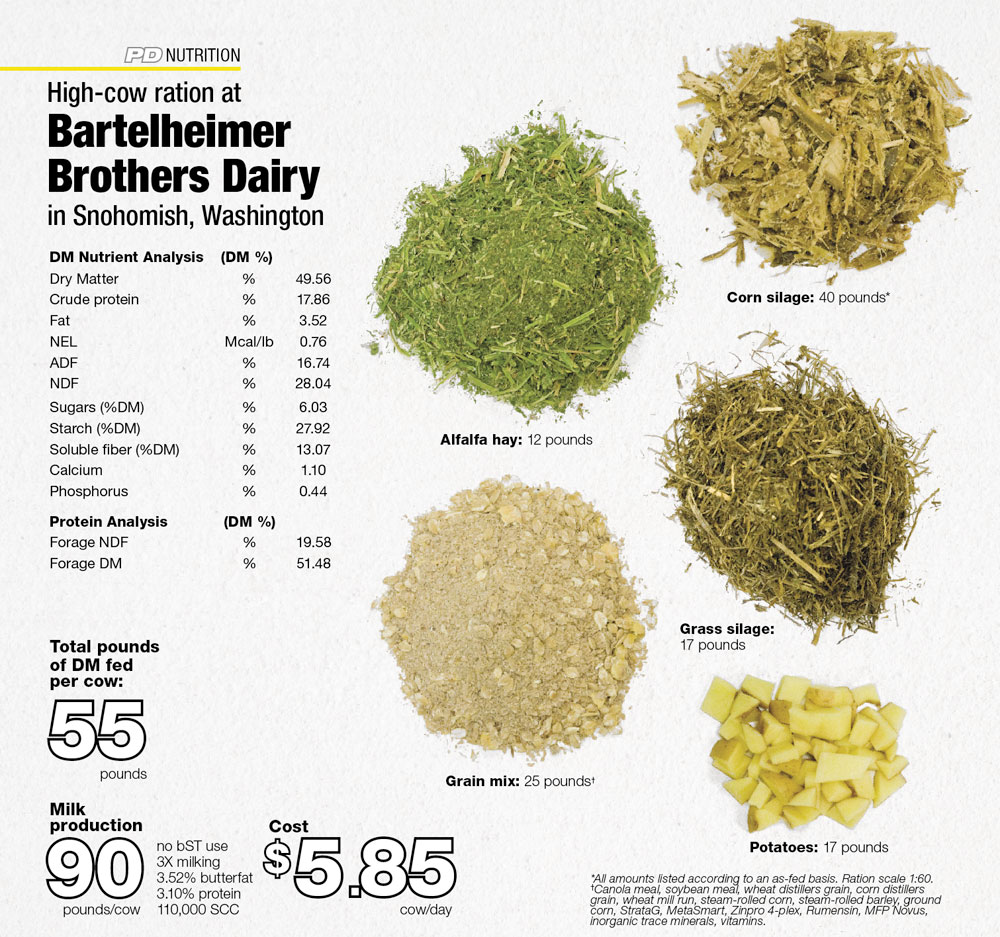Nutritionist Deb Wilks has been formulating “well-balanced, high-forage, healthy rations” for her clients in Washington for the past nine years. While other dairies struggled last year to make the right changes, some of them drastic, to their rations in order to account for lower milk prices, Wilks advised Bartelheimer Brothers Dairy, a 900-cow dairy and one of her 30 clients, to stick with ingredients that provide the best income over feed cost.
“They didn’t jump to lower- cost byproducts that wouldn’t benefit them,” Wilks said. “We stuck with what worked for this dairy when prices dropped.”
Instead, last year Wilks recommended the Bartelheimers manage their costs by adjusting protein sources in the ration, which is balanced for amino acids. For Wilks, a well-balanced ration means each ingredient pulls its own weight.
“Income over feed cost is always a concern,” Wilks says. “I want to make sure everything is paying for itself both in the long-term and short-term.”
Over the years, Wilks says she’s seen the effects of taking out high-performing ingredients from Bartelheimers’ ration. The amino acid balancing model shows on paper the trade-off, and Wilks says it doesn’t take long to see the effects in either production, milk protein or herd health. The ingredients usually end up going back in the ration. Wilks evaluates each ration ingredient based on the cost per unit of nutrient and then reviews the combined effect of all the nutrients before making changes for the 15,000 cows that she consults in Washington.
With Bartelheimers’ ration, Wilks is continuously monitoring forage stockpiles and their quality.
“Most of my rations are high in corn silage,” Wilks says. “High-quality corn silage is the best forage you can feed a lactating cow.”
Wilks says this dairy usually has good-quality forage, including hybrid yellow-dent corn silage, although the quantity available can be a concern. This year’s grass silage stockpile has already run short so Bartelheimer Brothers Dairy is buying high-quality hay to maintain a high level of forage fed. When good-quality forages run short, buying alfalfa obviously increases the ration cost. However, with high-quality forages, cow health and productivity improve, Wilks says.
“That’s why it is always worth high-quality forage, even if you have to pay for it. This dairy recognizes the benefits of higher-quality forages for the lactating cows,” she says.
Even with amino acid balancing and a few off-site purchased forages, Wilks still says she’s proud of the ration’s cost when considering the overall productivity of the cows.
Going forward, Wilks believes that to survive dairies will need to continue to be efficient and focus on health. She describes the feelings of her clients, who dairy in the counties surrounding Seattle’s Puget Sound, as “apprehensive” toward milk prices. She least looks forward to the next couple months when, if nothing changes, some of them may be faced with a lack of equity reserve, less than break-even milk prices and the real possibility of having to exit the dairy business.
“There has been a lot of cost- cutting in the past year,” Wilks says. “Some things will end up costing more in the long-term, which for cash flow, may have been necessary at the time.”
One area where last year’s cost-cutting is just now showing up, Wilks says, is the health and growth of replacement heifers.
“I’ve seen some dairies go through $9 milk that have cut necessary ingredients, not only for their cows, but for their heifers,” she says. “Cutting corners on heifers doesn’t pay for the future.””
Wilks says she’s proud that the Bartelheimers have not cut corners others have. Instead, they’ve tried to compensate for low prices with management and purchasing ingredients on a cost-per-unit-of-nutrient basis.
“Sometimes you will hear dairy producers talk and say, ‘I can’t get my cows to do this or that,’ and they blame their production on facilities,” Wilks says. “Bartelheimers is an older dairy. But it is a well-managed herd. They’ve been sticking with what works.” PD
Click on the image above to view it larger.

-
Deb Wilks
- Nutritionist
- Elenbaas
- Email Deb Wilks






